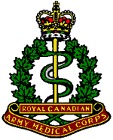THE BRITISH OVERSEAS RAILWAYS HISTORICAL TRUST
|  |
Royal Canadian Army Medical Corps

The Royal Canadian Army Medical Corps (RCAMC) cap badge.
History
The Militia Medical Service was established in 1898. It consisted of an Army Medical Service (officers) and an Army Medical Corps (other ranks).
The regimental medical personnel of the Permanent Active Militia were absorbed into the corps on 2 July 1904. The regular component was titled the "Permanent Active Militia Medical Corps" (PAMC) and the militia component was titled the "Army Medical Corps" (AMC). As the origin of a permanent medical corps, this date has since been considered the "birth" of the Royal Canadian Army Medical Corps for purposes of seniority among the corps of the Canadian Army, coming after the Royal Canadian Army Service Corps, 1903. (Though in the Militia the medical corps was the first of the support branches to be formed.)
Separate titles for permanent and non-permanent components of the medical corps were discarded during the re-organization of 1 May 1909. Thereafter, both permanent (regular) and non-permanent (reserve) components using the title "Canadian Army Medical Corps" (CAMC). The regular component of the service was redesignated "The Royal Canadian Army Medical Corps" on 3 November 1919; the militia component was granted the same honour on 29 April 1936.
Nursing Officers
Nurses were first employed by the Canadian military during the North-West Rebellion in 1885, being at that time civilian auxiliaries. Canada was one of the first nations to establish nurses as integral military personnel, first as officers of the militia (reserve) force in 1900, and in 1906 as officers of the regular force.
Integration and Unification
In 1959 the RCAMC joined with the medical services of the Royal Canadian Navy (RCN) and Royal Canadian Air Force (RCAF) to form the Canadian Forces Medical Service (CFMS). Medical personnel continued to wear the uniform of their respective service, but were functionally integrated under the professional direction of the newly created surgeon general of the Canadian Forces. Medical administration, personnel development and individual training were standardized within the CFMS in order to facilitate the operation of tri-service hospitals and joint medical headquarters. Fighting units continued to obtain integral medical support from their own uniformed personnel. Hospitals, medical headquarters, training schools and equipment depots and research facilities were staffed by CFMS members of all three services, resulting in a larger, more capable and more flexible organization (and more economical).
When the RCN, Canadian Army and RCAF were merged in 1968 to form the Canadian Forces, the RCAMC was deactivated in the Regular Force, and its personnel absorbed by the re-organized CFMS, which became a personnel branch of the new Canadian Forces. Reserve units of the RCAMC continued to exist, using their RCAMC titles, until re-organization of the Reserve Force in 1974, when the corps' final disbandment was effected.
Museum
Virtual museum at https://www.canmilmedmuseum.com/
|
| Registered Charity No 290944 | Company Limited by Guarantee No 1862659 |